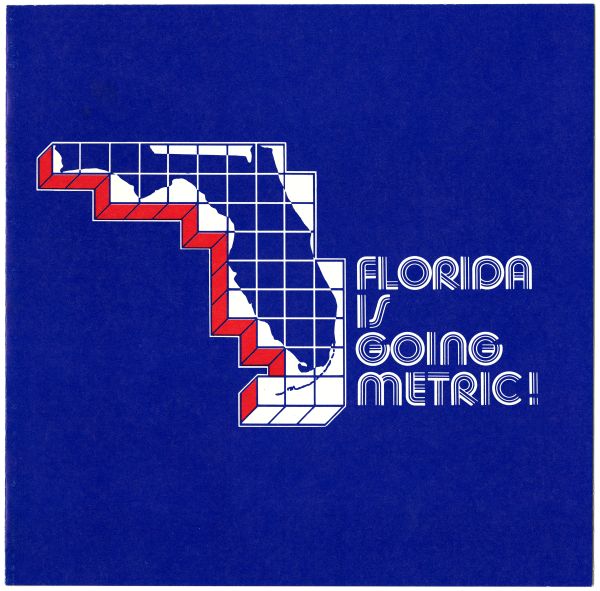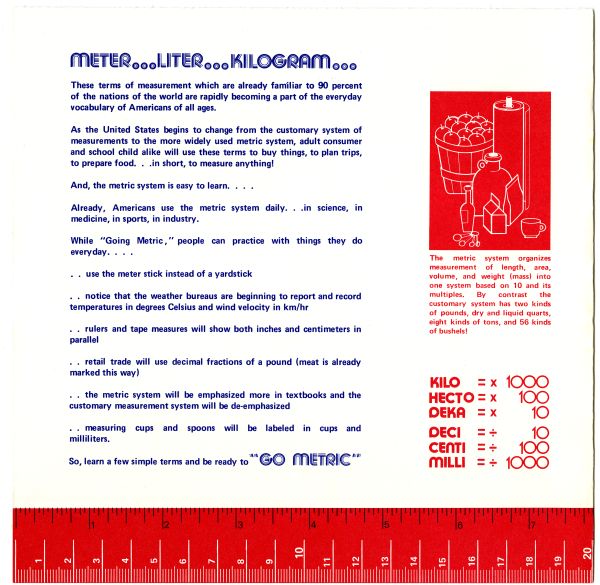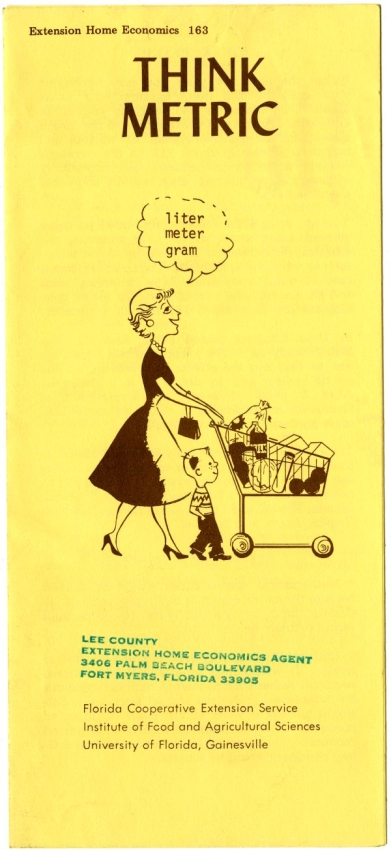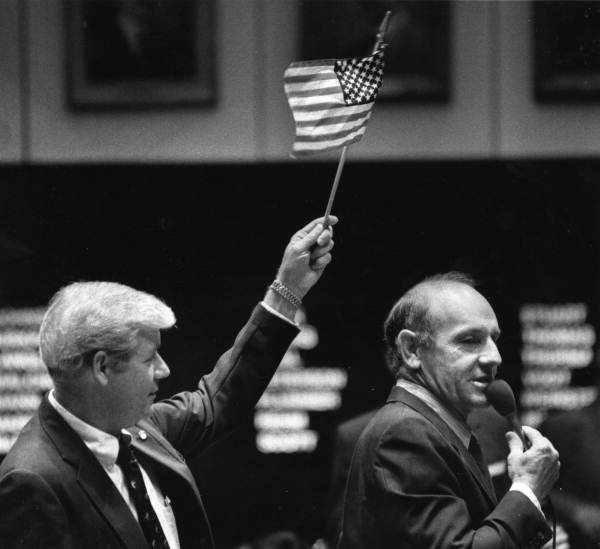Description of previous item
Description of next item
Follow the Liter
Published November 11, 2015 by Florida Memory
Have you ever wondered why we buy gasoline by the gallon, but purchase soft drinks in liter bottles? Or why track runners often race for a number of meters, yet long jumpers measure their achievements by feet and inches?
The United States has been flirting with the idea of adopting the metric system of measurement since 1866, but even today we remain on the fence. We use the old English standard in some cases, and the metric system in others. When a push to “go metric” surfaced in the 1970s, Florida’s state leaders launched a major campaign to prepare the public for the big change. The movement to go metric fizzled after a while, but it produced some interesting documents at the time, and even today it affects how students are taught units of measurement in math and science classes.

Brochure from the Florida Department of Education designed to help students learn the metric system (circa 1980). Click to view the entire brochure (Box 3, Folder 35, Florida Metric Council Planning Files – Series 1811, State Archives of Florida).
It all started in 1975, when President Gerald Ford signed the Metric Conversion Act into law, establishing a national policy for the increased use of the metric system. Congress had authorized the change over a century before, but decades of custom and familiarity had kept most people using the old English standard system. Increasingly, however, other countries with which the U.S. was doing business were switching to metric. Even the United Kingdom, where the English system had originated, dropped the old measurements in favor of metric in 1965. Upon signing the Metric Conversion Act, President Ford noted that over 90 percent of the world’s people were using metric – this law would make it easier for Americans to stay competitive in science and global trade.

Page from the brochure shown in the previous image. Metric conversion advocates stressed the convenience of the system’s reliance on units of 10.
In January 1976, Florida Commissioner of Education Ralph Turlington and Florida Commissioner of Agriculture Doyle Connor presented a draft resolution to the Governor Reubin Askew and his Cabinet calling for a steering committee to study the problems and requirements of metric conversion. The Cabinet approved the resolution, and in October 1976 the Florida Metric Council held its first meeting. The Council was made up of representatives from Florida’s schools, farmers, consumers, engineers, manufacturers, and other groups that would be greatly affected by the change.
One of the most critical aspects of the Council’s work was to figure out how to educate both children and adults about the purpose of switching to the metric system and how to convert traditional measurements into metric units. Council members believed this was essential for obtaining public support for the move. With this aim in mind, the Florida Metric Council partnered with a variety of state agencies to develop guides for the public, which explained the rationale for metric conversion and provided tips for doing the necessary math in daily activities like shopping and cooking.

A brochure (circa 1978) developed by the Florida Cooperative Extension Service to help everyday Floridians understand how metric conversion would affect common activities like shopping and measuring materials around the house (Box 139, Folder 12, Koreshan Unity Papers – Collection N2009-3, State Archives of Florida). Click to view the entire brochure.
Some folks believed metric conversion would solve a lot of problems. Since the metric system is based on units of 10, mathematical computations of distance, mass, and speed would be easier to compute. Manufacturers would also save time and money by using a single set of measurements to label packages and parts.
Others were more skeptical. Some people questioned the expense involved in a wholesale conversion to metric. Just replacing the speed limit signs, for example, was expected to cost somewhere around $200 million nationally. Others simply saw no reason for the United States to abandon a system that had been working so well for so long.

State Senator Dick Langley of Clermont argues against metric conversion, claiming that only drug dealers and communists would support the bill because drugs were sold in metric units and communist countries used the metric system. Senator George Kirkpatrick of Jacksonville waves a small American flag over Langley’s head (1984).
In Florida, as throughout the nation, mixed support for metric conversion led to mixed results. For example, Florida was the first state to require speed limits to be posted in both miles per hour and kilometers per hour on state highways. Those signs only lasted a year, however, before public disapproval led the Department of Transportation to scrap the program.
A more permanent legacy of the metric conversion debate is the way in which students are taught weights and measures in school. Even with the widespread preference for standard units of measurement like inches, pounds, and gallons, some aspects of life and work require knowledge of the metric system. This is especially true in the medical and scientific fields, where internationally-recognized standards are the norm. Florida teachers now prepare their students by teaching both systems of measurement, as well as the methods for converting from one to the other.
Which system of measurement do you use the most? Did you learn to use both systems when you were in school, or just one? Share your experiences by leaving us a comment on the blog below!
Cite This Article
Chicago Manual of Style
(17th Edition)Florida Memory. "Follow the Liter." Floridiana, 2015. https://www.floridamemory.com/items/show/321957.
MLA
(9th Edition)Florida Memory. "Follow the Liter." Floridiana, 2015, https://www.floridamemory.com/items/show/321957. Accessed November 25, 2025.
APA
(7th Edition)Florida Memory. (2015, November 11). Follow the Liter. Floridiana. Retrieved from https://www.floridamemory.com/items/show/321957

 Listen: The Blues Program
Listen: The Blues Program